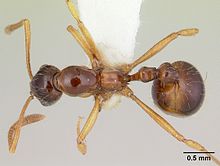When anyone mentions ants, you probably think of the small insects that make colonies within those little hills. Although it is true that many ants are social organisms, there are some ants that are social parasites. Unlike most ants and other social organisms, these ants exploit the sensory systems of a host with venom in order to raid their food. This exploitation can be harmful or deceptive and is usually designed to let the parasites enter the host’s home or subdue the host. Some ants nest near their hosts and periodically raid the fungus “gardens” that the hosts tend. M. mondabora (1), M. mondaboroides (2), and M. silvestrii (3) are all Megalomyrmex ants that raid distant relatives, C. costatus (4).

M. silvestrii (Ant 3) Source: WikiCommons
A recent study used the ants above to determine when the evolutionary transition to social parasitism took place. The researchers thought that Ant 1 could be the transitory species since it is both parasitic and free living at times. They compared the chemical compounds in free living or social ants to Ant 1. They found many similarities between all of them but were very distinct from venoms from Ant 2 and 3. This implies that Ant 1 could be an evolutionary transition from free living and social ants to social parasites and supports their hypothesis.
The same study also delves into how these ants use their venom to deal with their host. Ants 2 and 3 both exploit 4 with their specific blend of venom. Ants 2 and 3 use pyrrolidine and pyrolizidine as their main venom component, respectively. During raids, the thieves are very fast and tear apart the carefully tended fungus gardens. However, Ants 2 and 3 deal with the hosts in very different ways. Ant 2 tends to disperse its venom by vigorously wagging its stinger back and forth in order to make an aerosol. This aerosol tends to make the host play dead before the ants even interact directly. While being raided by Ant 2, the Ant 4 colony tend to be very submissive and go about their antsy business. This is thought to be mainly deceptive and reduces confrontation. On the other hand, Ant 3 isn’t so nice: it stings the host first and asks questions later. This also tends to send Ant 4 into a full panic and even try to fight back against Ant 3. However, they are too weak to effectively fight back and just get stung more. Unlike Ant 2, Ant 3 is large enough to fight Ant 4 and win handily.
A venom component of Ant 2. Source: WikiCommon
In addition to different techniques of dealing with the hosts, Ant 2 was found to have a novel venom compound for its species. It has a special component that is only found in distant relatives. This means that this specific compound convergently evolved since it wasn’t present in the most common ancestor. This came as a surprise to the researchers since it is generally costly to make new venoms but it could be the secret component to deceive Ant 4. More research should be done in order to determine the specific compound or mixture of compounds that appease the host and allow for a sneakier raid.

Cyphomyrmex costatus (Ant 4) Source: alexanderwild.com
This study provides molecular evidence for evolutionary history of certain ants. It works around two major transitions in venom composition and behavior: appeasement venom and social parasitism as a whole. These two transitions are very important to understanding how and why certain traits evolve within ants. Not only that but this sort of methodology can be translated to any set of organisms where the evolutionary history is murky.
Reference:
Adams, R.M. et al.. (2015). Alkaloid Venom Weaponry of Three Megalomyrmex Thief Ants and the Behavioral Response of Cyphomyrmex costatus Host Ants. Journal of Chemical Ecology. 41: 373–385.
